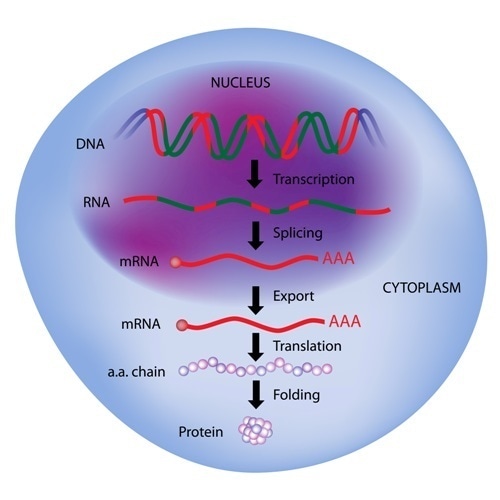Transcription is the first step in the synthesis of proteins from specific gene sequences. In this process, the genetic information in the DNA is copied to an mRNA with the help of an enzyme called RNA polymerase and several transcription factors.
Once the mRNA is formed, it undergoes a series of transformations called post-transcriptional modifications to form a mature mRNA, which is transported from the nucleus to the cytoplasm where protein synthesis occurs with the help of ribosomes.
In prokaryotes such as bacteria, the initial mRNA produced after transcription is mature and fully functional to take part in the subsequent steps of protein synthesis. Therefore, the need for post-transcriptional modifications is eliminated.
Also, as the prokaryotic cell lacks a clearly defined nucleus and both transcription and translation takes place in the cytoplasm, there is no need to transport the mRNA to the cytoplasm after transcription, making the entire process of gene expression much simpler compared to that in eukaryotes.

Image Copyright: Alila Medical Media, Image ID: 106263554 via Shutterstock
Key Steps in Transcription
There are 3 main steps in transcription: initiation, elongation, and termination. These 3 steps are briefly explained below.
Initiation
To begin with, transcription factors recognize specific nucleotide sequences known as promoter regions in the DNA. RNA polymerase then binds to the promoter region of the gene which contains the initiation site for transcription. RNA polymerase unwinds the dsDNA forming single strands which can serve as a template for mRNA synthesis.
Elongation
Next, RNA polymerase adds nucleotides complimentary to the 3’ end of the template DNA strand to form the corresponding mRNA strand. The process goes on as the RNA polymerase advances along the DNA template adding complimentary bases and thus elongating the mRNA strand. Several copies of a gene may be produced after multiple rounds of transcription.
Termination
RNA polymerase moves along the DNA until it encounters a specific nucleotide sequence called the terminator sequence which triggers the end of transcription. Once transcription stops, the enzyme and the mRNA transcript disengage from the template DNA, which re-winds to form a double helix. The mRNA transcript or pre-mRNA is then released for post-transcriptional modifications that make it a mature mRNA ready for translation.
Post-Transcriptional Processing
In eukaryotic gene expression, the mRNA transcript produced by transcription of DNA undergoes a series of processes such as splicing, 3’ polyadenylation, and 5’ capping, all of which helps in making it fully functional for translation. These processes are explained briefly below.
Splicing
Eukaryotic primary mRNA often contains non-coding sequences called introns in between coding sequences called exons. These unnecessary introns are removed or spliced with the help of a multi-component protein called the spliceosome.
The proteins in the spliceosome recognize and bind to the splice sites at the 3’ and 5’ end of the introns. The intron is cut at the splice sites and the resulting loose ends of exons are joined. Once all the introns in a pre-mRNA are removed, the spliceosome disengages from the mRNA transcript leaving behind mRNA having only the coding sequences or exons.
3’ Polyadenylation
Polyadenylation refers to the addition of several adenine residues to the 3’ end of the primary mRNA. This is carried out with the help of an enzyme called poly(A) polymerase, which can add up to 200 adenine bases to the 3’ end of the mRNA transcript. The 3’ end after polyadenylation is called a poly A tail and is believed to play important roles in preventing mRNA degradation and regulation of protein synthesis.
5’ Capping
Once the mRNA transcript is about 30 nucleotides long, a modified guanine nucleotide is added to its 5’ end. This is called 5’ capping, which protects the 5’ end of the mRNA from enzymatic degradation and is also said to help in the transport of mRNA from the nucleus to the cytoplasm.
References
Further Reading
Last Updated: Jul 22, 2023